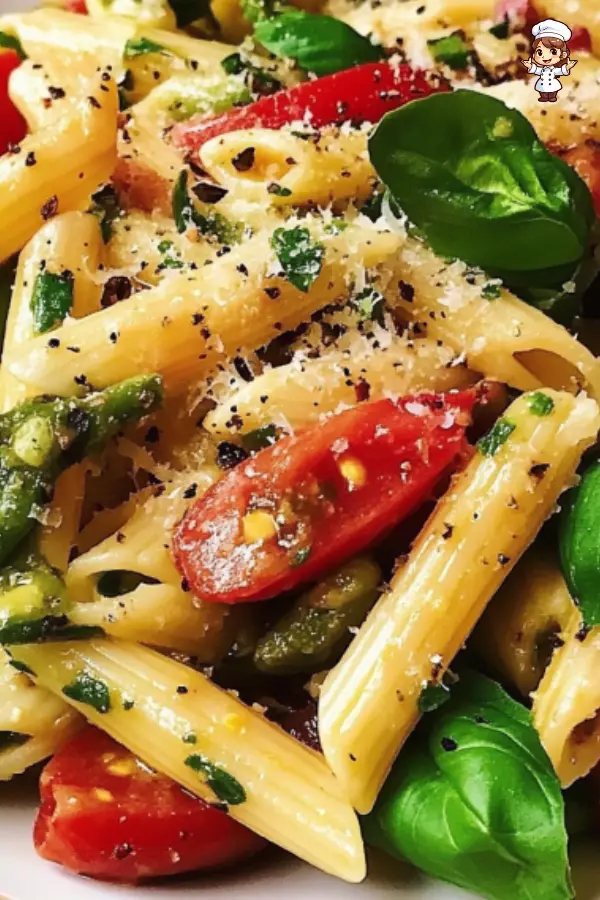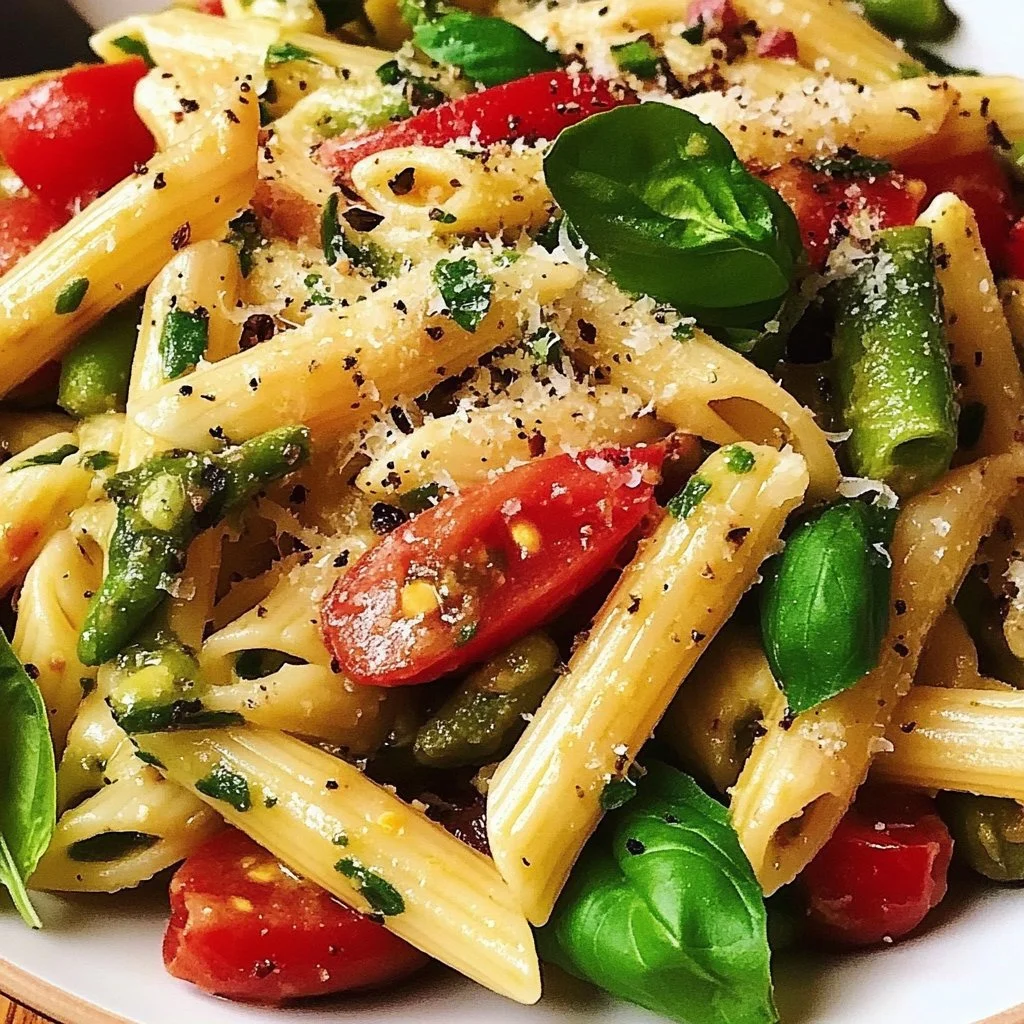Spring Pasta is a vibrant dish that perfectly captures the essence of the season. With fresh vegetables that burst with flavor and color, it brings brightness to your dining table, making it an ideal choice for family meals or gatherings with friends. The gentle tang of lemon juice, combined with the richness of Pecorino cheese and the fragrant herbs, creates a delightful harmony that highlights the natural sweetness of the spring produce. This easy-to-follow recipe not only showcases the best of seasonal ingredients but also encourages a healthy and balanced meal that everyone can enjoy.
Fresh penne pasta serves as the base for this dish, providing a sturdy and hearty texture that complements the tender vegetables. The mix of garlic, zucchini, squash, asparagus, and peas offers a medley of nutrients and tastes, while cherry tomatoes add a sweet burst to each bite. Finished off with a drizzle of olive oil and a sprinkle of red pepper flakes, Spring Pasta is sure to become a new favorite in your recipe collection.
This dish is versatile enough to cater to various preferences, whether you’re looking for a simple vegetarian meal or a base for more protein. Paired with a light salad or crusty bread, Spring Pasta can be transformed into a delightful dining experience that celebrates the beauty of spring.
Ingredients about Spring Pasta
List of ingredients with measurements
- 10 ounces penne pasta
- 2 tablespoons extra virgin olive oil, plus more for drizzling
- 4 garlic cloves, sliced
- 1 yellow squash, sliced into thin half moons
- 1 zucchini, sliced into thin half moons
- 1 bunch asparagus, chopped into 1-inch pieces
- 1 cup cherry tomatoes, halved
- 1 cup thinly sliced red onion
- 1 teaspoon sea salt
- 1/2 cup frozen peas, thawed
- 3/4 cup grated Pecorino cheese
- 3 tablespoons fresh lemon juice
- Red pepper flakes, to taste
- 1 cup fresh basil leaves, plus more for garnish
- 1/4 cup fresh tarragon (optional)
- Freshly ground black pepper, to taste
Optional ingredient substitutions
If you find yourself lacking some ingredients, there are easy substitutions you can consider.
- Instead of penne pasta, you can use fusilli or farfalle for a different shape.
- Olive oil can be replaced with avocado oil to give a slightly different flavor.
- If you don’t have yellow squash, green squash works just as well.
- For cheese, Parmesan could substitute for Pecorino in case that’s what you have on hand.
- If you’re out of fresh herbs, dried basil and tarragon can also work, but reduce the amount as they are more concentrated.
How to Make Spring Pasta

Step 1: Detailed instruction
To start, prepare a large pot of salted water and bring it to a boil over high heat. This will be used to cook the penne pasta. Once the water is boiling, add the penne and cook it according to the package instructions until it reaches an al dente texture. Al dente means the pasta should be firm to the bite. After cooking, drain the pasta in a colander and drizzle a little extra virgin olive oil over it to prevent sticking. Toss the pasta gently in the oil before setting it aside.
Step 2: Detailed instruction
Next, heat 2 tablespoons of olive oil in a large, deep skillet over medium heat. Once the oil is warmed, add the sliced garlic. Sauté the garlic for about 1 minute until fragrant but not burnt. Then, add the yellow squash, zucchini, asparagus, cherry tomatoes, and red onion to the skillet. Sprinkle in the sea salt and several grinds of black pepper. Sauté the mixture for 3 to 4 minutes. Keep stirring gently until the vegetables soften and their colors brighten, making sure not to overcook them as you want to keep some crunch.
Step 3: Detailed instruction
Now it’s time to combine the pasta and the vegetables. Add the drained penne to the skillet along with the thawed peas. Next, sprinkle in the grated Pecorino cheese, and drizzle fresh lemon juice over the top. For those who enjoy a little heat, add a pinch of red pepper flakes. Toss everything together until the pasta is well-coated with the vegetables and cheese, giving the dish a beautiful blend of colors.
Step 4: Detailed instruction
Finish off the pasta by folding in the fresh basil leaves and, if you’re using it, tarragon. Give it a gentle stir to distribute the herbs throughout the dish. Taste your Spring Pasta and adjust the seasoning, adding more salt, pepper, or red pepper flakes according to your preference. Serve immediately by garnishing each plate with a few basil leaves and an extra drizzle of olive oil if you like.
How to Serve Spring Pasta
Best ways to serve Spring Pasta
Spring Pasta is best served fresh out of the skillet while it’s still warm. The vibrant colors and fresh aromas make it a visually appealing dish that can brighten any table. You can dish it out onto plates or serve it family-style in a large bowl for everyone to help themselves.
Serving suggestions or pairings
This dish pairs beautifully with a variety of sides. A crisp, green salad topped with a light vinaigrette complements the flavors of the pasta nicely. You could also consider serving it alongside garlic bread or a simple bruschetta for added enjoyment. If you want to make it a more filling meal, grilled chicken or shrimp can easily be added on the side for those who prefer a protein boost.
How to Store Spring Pasta
Proper storage methods
If you have leftovers of your delicious Spring Pasta, you can store them for later enjoyment. Allow the pasta to cool down to room temperature before transferring it to an airtight container. Make sure to seal it well to retain its flavors and textures. In the refrigerator, the pasta can last for about 3 to 5 days.
Tips for reheating or freezing
When reheating, you can warm it up in the microwave for about 1 to 2 minutes, or in a skillet over low heat, adding a splash of water or olive oil to prevent it from drying out. If you want to freeze the Spring Pasta, it’s best to do so before adding any fresh herbs or garnishes; it can keep in the freezer for about 2 to 3 months. To reheat frozen pasta, thaw it in the fridge overnight before warming it as mentioned above.
Tips to Make Spring Pasta
Common mistakes to avoid
One of the most common mistakes when making pasta is overcooking it. Make sure to keep an eye on the cooking time to achieve that perfect al dente texture. Also, be cautious with salt; remember that some cheese varieties, like Pecorino, are salty. Adjust the amount gradually as you season the dish. Finally, avoid adding too many vegetables at once, as this can lead to steaming rather than sautéing, which won’t give you the desired tender-crisp texture.
Helpful tips for better results
Use the freshest vegetables you can find, as they will enhance the flavors significantly. Seasonal produce always tastes better. If you have it, a splash of white wine added during the sautéing process can enhance the depth of flavor and create a wonderful aroma. When adding herbs, you can chop them roughly or even tear them by hand to release their oils, making the dish brighter and more fragrant.
Variation of Spring Pasta
Suggested variations or twists on the recipe
Feel free to customize your Spring Pasta by adding ingredients that you love or have on hand. You might try incorporating bell peppers, artichoke hearts, or even some spinach for added nutrients. For a creamier sauce, consider adding a splash of heavy cream or a dollop of ricotta cheese to the mix. If you want a non-vegetarian version, sautéing some diced chicken or shrimp along with the vegetables can provide a hearty twist.
Adjustments for dietary preferences
For those following gluten-free diets, using gluten-free penne or any preferred pasta alternative works wonders. If you’re looking for a vegan version, simply omit the cheese or substitute it with a plant-based alternative. You can also replace the butter with a plant-based oil or spread that works for you. This makes the dish accessible for a wide variety of dietary needs.
FAQs
What can I do if the dish isn’t turning out right?
If your Spring Pasta isn’t quite right, try to identify the problem. If it tastes bland, it might need more salt or seasoning. If overcooked, the solution is some well-chosen toppings or a splash of sauce to add moisture. Additionally, don’t hesitate to add olive oil or a squeeze of lemon juice for an extra boost of flavor.
Can I make this ahead of time?
Yes, Spring Pasta can be made ahead of time and stored in the refrigerator for several days. If you plan to serve it later, consider slightly undercooking the pasta by a minute or two so that when you reheat it, it doesn’t become too soft. You can prepare all the vegetables ahead and store them separately to keep everything fresh.
What can I substitute for ingredients?
If you run out of any ingredients, don’t panic! Penne can be replaced with any pasta you prefer. Fresh vegetables can also be mixed and matched with what you have available, like broccoli, snap peas, or bell peppers. Cheese can be swapped for whatever you have in your fridge—like Parmesan or even feta for a different flavor profile. Experimenting with the ingredients is half the fun with Spring Pasta!
In conclusion, Spring Pasta is a delightful dish that celebrates the fresh and vibrant flavors of spring. This recipe offers a simple way to create a healthy, colorful meal that’s loved by all. From the gentle saute of fresh vegetables to the bright notes of lemon and herbs, it’s hard not to fall in love with this nourishing dish. So gather your ingredients and get ready to enjoy a plate full of springtime goodness!
Print
Spring Pasta
- Prep Time: 15 minutes
- Cook Time: 15 minutes
- Total Time: 30 minutes
- Yield: 4 servings 1x
- Category: Main Course
- Method: Sautéing
- Cuisine: Italian
- Diet: Vegetarian
Description
A vibrant dish that captures the essence of spring with fresh vegetables, tangy lemon, and rich Pecorino cheese.
Ingredients
- 10 ounces penne pasta
- 2 tablespoons extra virgin olive oil, plus more for drizzling
- 4 garlic cloves, sliced
- 1 yellow squash, sliced into thin half moons
- 1 zucchini, sliced into thin half moons
- 1 bunch asparagus, chopped into 1-inch pieces
- 1 cup cherry tomatoes, halved
- 1 cup thinly sliced red onion
- 1 teaspoon sea salt
- 1/2 cup frozen peas, thawed
- 3/4 cup grated Pecorino cheese
- 3 tablespoons fresh lemon juice
- Red pepper flakes, to taste
- 1 cup fresh basil leaves, plus more for garnish
- 1/4 cup fresh tarragon (optional)
- Freshly ground black pepper, to taste
Instructions
- Prepare a large pot of salted water and bring it to a boil. Add the penne and cook until al dente. Drain and drizzle with olive oil.
- Heat 2 tablespoons of olive oil in a skillet over medium heat, add garlic, and sauté for 1 minute. Add squash, zucchini, asparagus, cherry tomatoes, and onion. Season with sea salt and pepper. Sauté for 3 to 4 minutes.
- Add the drained pasta and thawed peas to the skillet. Sprinkle with Pecorino cheese and drizzle with lemon juice. Toss to combine.
- Fold in basil and tarragon. Adjust seasoning as needed and serve warm with extra basil and olive oil.
Notes
If desired, substitute with different pasta shapes or cheeses. For a vegan option, omit cheese or use plant-based alternatives.
Nutrition
- Serving Size: 1 serving
- Calories: 350
- Sugar: 5g
- Sodium: 400mg
- Fat: 12g
- Saturated Fat: 4g
- Unsaturated Fat: 6g
- Trans Fat: 0g
- Carbohydrates: 45g
- Fiber: 3g
- Protein: 15g
- Cholesterol: 30mg
Keywords: spring pasta, vegetarian pasta, seasonal vegetables, easy pasta recipe

